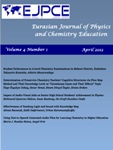Effectiveness of Teaching Light and Sound with Knowledge Map
DOI:
https://doi.org/10.51724/ijpce.v4i1.93Keywords:
Science Education, Knowledge Map, Light and SoundAbstract
The purpose of this study is to investigate the effect of knowledge mapping technique upon meaningful learning through the process of teaching light and sound to primary school 6th grade students. In this study, pre-test and post-test controlled group experimental design model was applied. Data has been collected by applying “Light and Sound” success test to primary school 6th grade students. From the obtained data, significant difference has been noted between experimental and control groups in favor of the experimental group. This finding showed us that using knowledge mapping technique in the subject of “Light and Sound” was effective in increasing the level of success. At the end of the study some necessary suggestions were made to whom it may concern.
Downloads
References
Bacanak, A., Karamustafaoğlu, S., Değirmenci, S. ve Karamustafaoğlu, O. (2011). Fen öğretiminde bilgi haritası kullanımı: Ekosistem örneği, Dicle Üniversitesi Ziya Gökalp Eğitim Fakültesi Dergisi, 17, 133-145.
Çepni, S. (2010). Araştırma ve Proje Çalışmalarına Giriş, 5. Baskı, Trabzon.
Gagne, R.M. (1988). Essential of Learning For Instuction, Englewood Cliffs, Nj: Prentice-Hall.
Heinze-Fry, J.A. & Novak, J.D. (1990). Concept mapping brings long-term movement toward meaningful learning, Science Education, 74(4), 461-472.
Karamustafaoğlu, O. (2003). Fen bilgisi ve fizik öğretmen adaylarının kazanmaları istenen becerileri yansıtabilecekleri ortamların düzenlenmesi, Yayınlanmamış Doktora Tezi, Fen Bilimleri Enstitüsü, KTÜ, Trabzon.
Karamustafaoğlu, O., Yaman, S. & Karamustafaoğlu, S. (2005). Fen ve Teknoloji Eğitiminde Öğrenme ve Öğretim Materyalleri: Bölüm 9 s. 211-234, İlköğretimde Fen ve Teknoloji Öğretimi (Ed: T. Kesercioğlu & M. Aydoğdu), Ankara: Anı Yay.
Karamustafaoğlu, O. (2009). Active learning strategies in physics teaching, Energy Education Science and Technology Part B: Social and Educational Studies, 1(1), 27-50.
Karamustafaoğlu, S., Bacanak, A., Değirmenci, S. ve Karamustafaoğlu, O. (2010). Ses kavramına yönelik bir çoklu zeka etkinliği, Batı Anadolu Eğitim Bilimleri Dergisi, 1(2), 125-139.
Karamustafaoğlu, O. & Yaman, S. (2011). Fen Eğitiminde Özel Öğretim Yöntemleri I-II, 3. Baskı, Ankara: Anı Yay.
McCagg, E.C. & Dansereau, D.F. (1991). A convergent paradigm for examining knowledge mapping as a learning strategy, Journal of Educational Research, 84, 317-324.
Novak, J.D., Gowin, D.B. & Johansen G.T. (1983) The use of concept mapping and knowledge vee mapping with junior high school science students, Science Education, 67(5), 625-645.
O’Donell, A.M. (1994). Learning from knowledge maps - the effects of map orientation, Contemporary Educational Psychology, 19(1), 33-44.
Özer, B. (2002). Learning strategies in primary and secondary schools' curricula, Educational Sciences & Practices, 1(1), 17-32.
Senemoğlu, N. (2007). Gelişim, Öğrenme ve Öğretim: Kuramdan Uygulamaya. (13. Baskı). Ankara: Gönül Yay. ve Matbaacılık.
Tay, B. (2007). Öğrenme stratejilerinin hayat bilgisi ve sosyal bilgiler öğretimi dersinde akademik başarıya etkisi, Milli Eğitim, 173, 87-102.
Weinstein, C. (1988). Assesment and Training of Student Learning Strategies. Learning Strategies and Learning Strategies. Ed: Ronald R. Schmeck. Newyork, Plenum pres.
Weinstein, C.E. & Mayer, R.E. (1986). The Teaching of Learning Strategies Handbook of Research on Teaching. 3rd Edition, Editor: M.C. Wittrock. New York: Macmillan Company.
Yin, R.K. (2009). Case Study Research, Design and Methods. (4th Ed.) Thousand Oaks, CA: Sage Publigations.
Downloads
Published
How to Cite
Issue
Section
License
Copyright (c) 2012 Eurasian Journal of Physics & Chemistry Education

This work is licensed under a Creative Commons Attribution-NonCommercial 4.0 International License.
Copyright © Authors






